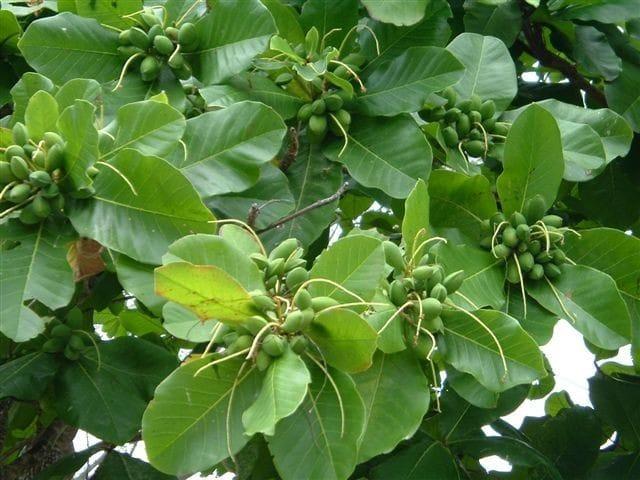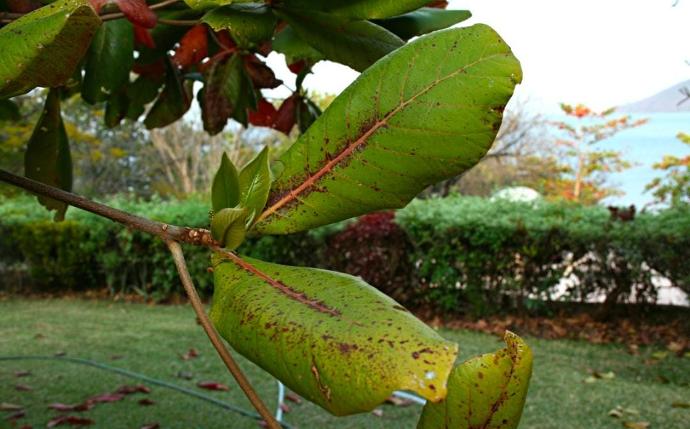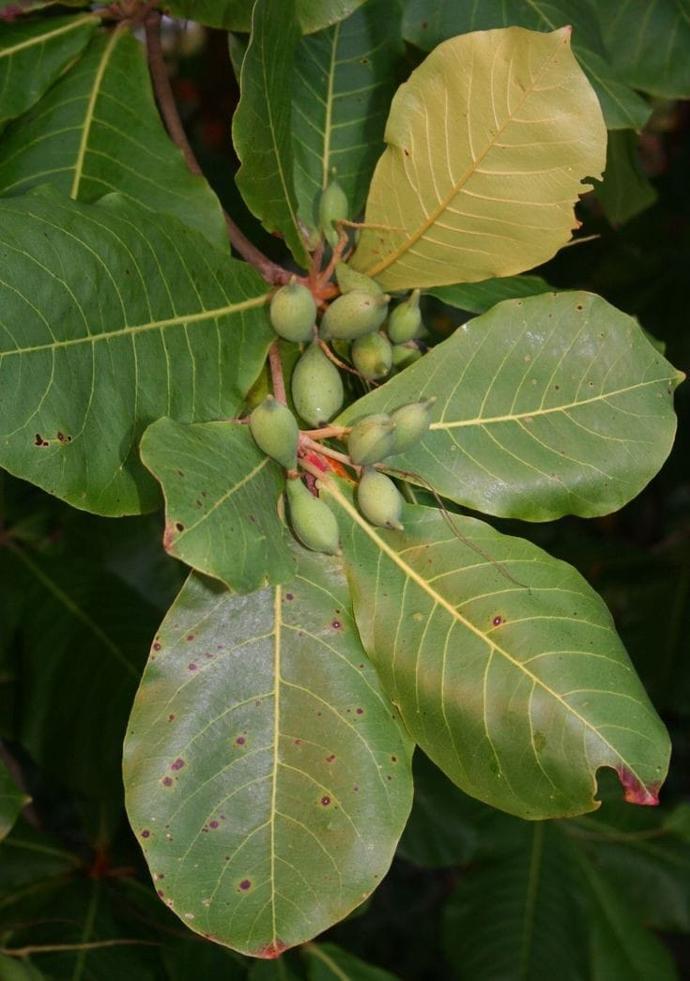Terminalia/Indian Almond Plant
TERMINELIA, commonly called as Indian Almond or Tropical Almond, possibly referring to a specific plant variety or species, may have varying care requirements. Generally, provide well-draining soil, appropriate sunlight, and regular watering. Pruning and fertilizing practices may vary based on the specific characteristics of this plant.
Habit
Shrub/Tree
Height
10 to 20 m
Growth
Moderate
Soil
Well-drained, Sandy Loam
Shade
Full Sun
Moisture
Moist
Edible
Yes
Medicinal
Yes
Origin
India, Southeast Asia
Climatic Condition
Tropical, Subtropical
Temperature (°)
25°C to 35°C
Humidity (%)
60% to 80%
Potting media
50% Loam, 40% Sand, 10% Organic Matter
Fertilizers
Organic Fertilizer
Watering
Regular watering
Plant Weight
10 to 15 kg
Flowering Time
Summer to Fall
Soil Ph level
6.0 to 7.5
Water Ph level
6.0 to 7.0
Soil EC
0.6 to 1.2 mS/cm
Yield Per Plant
100 to 200 kg per tree
NPK ratio
10:10:10
life Span
30 to 50 years
Health Benefits
High in Nutrients, Medicinal
Suggested Grow Media or Potting Mix ?
40% compost, 30% peat moss, 30% perlite
Suggested Fertigation/Fertilizers
Fertilize every 4 weeks with a balanced, water-soluble fertilizer.
Common Diseases and Remedies
Black nodal girdling , Leaf Curl
Symptoms begin from nectar gland and gradually spread to lower petiole region.
Plucking and burning of infected leaves.
HEALTH BENEFITS
1. Antioxidant properties: Terminalia contains antioxidants that can help protect against oxidative stress and inflammation.
2. May help lower cholesterol: The fiber and antioxidants in Terminalia may help lower cholesterol levels and improve heart health.
3. May help regulate blood sugar: Terminalia's fiber and antioxidants may also help regulate blood sugar levels.
What is a Terminaria plant?
Terminaria plant: Terminaria is a genus of flowering plants in the Combretaceae family. It includes approximately 200 species of trees and shrubs found primarily in tropical and subtropical regions around the world. Many Terminaria species are valued for their medicinal properties, wood, and ornamental value.
What Are The Different Types Of Terminalia?
Terminalia Arjuna
This species is also called Arjuna and is native to the Indian subcontinent. It is a large deciduous tree with smooth gray bark and oval leaves. Terminaria arjuna is highly valued in Ayurvedic medicine for its cardiovascular benefits.
Terminaria catappa
Commonly called Indian almond or tropical almond, this species is native to tropical Asia and northern Australia. It is a medium-sized tree with large, glossy leaves and edible fruit. Terminaria catappa is often planted as an ornamental shade tree.
Terminalia chebula
Known as Haritaki, native to South and Southeast Asia. It is a medium-sized deciduous tree with oval leaves and small greenish-yellow flowers. Terminaria chebura is used in traditional medicine for its digestive and rejuvenating properties.
Terminalia ivorensis
This species, also known as the Ivorian almond or Idigbo, is native to West Africa. It is a large tree with a straight trunk and dark brown bark. Terminalia ivorensis is valued for its timber, which is used in construction and furniture making.
How To Care For Terminalia?
Location
Plant terminalia in a location with well-drained soil and plenty of sunlight. Most species prefer full sun but can also tolerate partial shade.
Sunlight
Terminaria plants grow in areas that receive plenty of sunlight. Therefore, make sure it gets at least 6-8 hours of direct sunlight per day.
Soil
Use well-drained soil with slightly acidic to neutral pH. Terminalia plants can adapt to many different soil types, but prefer fertile, loamy soils.
Hydration
Water your Terminaria plants regularly, especially during hot, dry weather. However, Terminaria plants are prone to root rot, so avoid allowing water to accumulate in the soil.
Nourishment
Feed a balanced fertilizer during the growing season to promote healthy growth of Terminaria plants. Additionally, mulching around the base of your plants will help retain moisture and suppress weeds.
Issues
Terminalia plants can be susceptible to pests such as aphids, scale insects, and caterpillars. In addition, fungal diseases such as powdery mildew and root rot can occur, especially in humid conditions. Regular inspections, proper watering, and good air circulation can help prevent these problems.
What Are The Benefits Of Terminaria?
Medicinal uses: Many Terminaria species have medicinal properties and are used in traditional medicine to treat a variety of digestive problems, cardiovascular problems, skin diseases, etc. It is used for various diseases.
Wood: Some species of Terminalia produce valuable wood used in architecture, furniture making, and shipbuilding.
Ornamental Value: Several species of Terminalia are cultivated for their attractive foliage, flowers, and general ornamental value in gardens and landscapes.
FAQs About Growing Terminaria ?
How tall do Terminaria plants grow?
The height of Terminaria plants varies depending on the species. Some species, such as Terminaria arjuna, can grow up to 24 meters in height, while others, such as Terminaria chebula, are smaller and reach around 15 meters in height.
How often should Terminaria plants be pruned?
Pruning requirements vary depending on the type of plant and desired shape. Generally, terminaria plants are pruned in late winter or early spring to remove dead or diseased branches and promote healthy growth.
Are Terminalia plants drought tolerant?
Terminaria plants can tolerate some drought once established, but they prefer regular watering, especially in hot, dry weather. Adequate watering is important to promote healthy root development.

